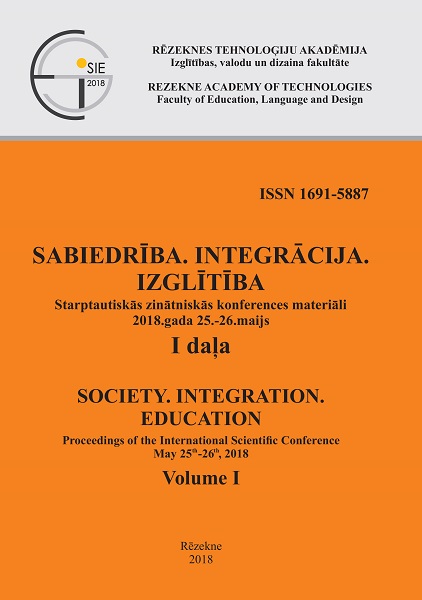BUILDING POSITIVE GROUP DYNAMICS IN ENGLISH LANGUAGE TEACHING AT TECHNICAL UNIVERSITY
DOI:
https://doi.org/10.17770/sie2018vol1.3114Keywords:
corporate culture, engineering education, foreign language, frame approach, games in English, psychodrama approach, teaching system, “team-building” technologyAbstract
This paper is a report on the findings of a study conducted at Samara state technical university, at the faculty of engineering economics. The research is devoted to building positive group dynamics and interactive methods in ELT that are used to provide a positive group atmosphere. The author considers various interpretations of the concept “interactive methods”, analyses their effectiveness and develops a specific system of foreign language teaching that is focused on the participation of all students in the speech process and chooses “team-building technology” as a core element of this system and as a type of interactive methods that include complex of games in English. The results of the study prove that implementation of such games efficiently improves language level and builds a positive group dynamics.
References
Armstrong, M. (2008). Human resource management practice. Kogan page: London and Philadelphia, 565-566.
Baidenko, V.I., & Belov E.B. (2005). Designing state educational standards of professional education of a new generation. Scientific journal of TGPU. Section “Pedagogics”, 11(126), 135-141.
Bradley, J. H., & Frederic, J. H. (1997). The effect of personality type on team performance. Journal of Management Development, 16(5), 337-353.
Dearden, J. (2014). English as a medium of instruction – a growing global phenomenon: Phase 1 interim report. British Council. Retrieved from http://www.britishcouncil.org/education/ihe
Felder, R.M., & Silverman, L.K. (1988). Learning and Teaching Styles in Engineering Education. Engineering Education, 78(7), 674-681.
Hackman, J. R., & Wageman, R. (2005). A theory of team coaching. Academy of Management Review, 30(2), 269–287.
Harrison, D. A., Price, K. H., Gavin, J. H., & Florey, A. T. (2002). Time, teams, and task performance: Changing effects of surface- and deep-level diversity on group functioning. Academy of Management Journal, 45(5), 1029–1045.
Kashina, E.G. (2012) Communicative-theatrical method of teaching English: multiple intelligence formation. Samara: Samara University, 122-123.
Katz, D., & Kahn, R. L. (1966). The social psychology of organizations. New York, NY: Wiley.
Katz-Navon, T. Y., & Erez, M. (2005). When collective- and selfefficacy affect team performance. Small Group Research, 36, 437–465.
Kirkman, B. L., & Mathieu, J. E. (2005). The dimensions and antecedents of team virtuality. Journal of Management, 31(5), 700–718.
Nikishina, V.O. (2013). Interactive methods of teaching English. Students scientific forum, 56-62.
Obskov, A.V. Problems of organization of interactive English teaching. Scientific journal of TGPU. Section “Pedagogics”, 11(126), 120-124.
Rhoads, J.R., Nauman, E , Holloway B.M, Krousgrill Ch.M. The Purdue Mechanics Freeform Classroom: A New Approach to Engineering Mechanics Education. Oxford: Macmillan Education.
Richards, J. C. & Rogers, T. S. (2014). Approaches and methods in Teaching. Cambridge: CUP.
Smith, K. (1996). Cooperative Learning: make groupwork work. New Directions for Teaching and Learning, 67, 71-82.
Vygotsky, L. S. (1978). Mind in Society. Cambridge, MA: Harvard University Press.
Wageman, R. (1997). Critical success factors for creating superb self-managing teams. Organsiational Dynamics, 26 (1), Summer, 49-62.






